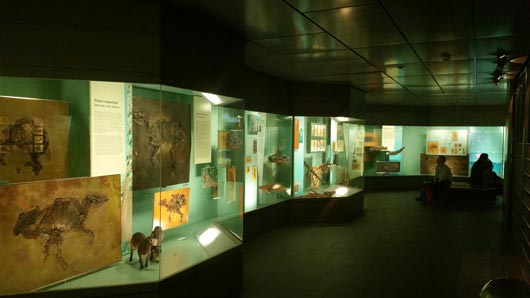The oldest harvestmen known from Germany have been described. This is the first formal description of fossil harvestmen from the Eocene. The newly described harvestmen (Arachnida: Opiliones), come from the famous Messel Pit fossil deposit. The fossils are believed to be around 47-48 million years old. Writing in the journal “Palaeobiodiversity and Palaeoenvironments” the research team describe these arachnids as Leiobunum messelense sp. nov. and Leiobunum schaali sp. nov.
The research team concluded that these “daddy long legs” arachnids were iridescent. Iridescent harvestmen today are found in tropical rainforests. Their discovery in the Messel shale helps to support the theory that in the Eocene this was a subtropical or tropical forest habitat. In the past, tropical arachnids lived in Germany, perhaps they will again due to climate change.
Picture credit: Senckenberg
The Oldest Harvestmen
Harvestmen (Arachnida: Opiliones) are one of the most diverse lineages of arachnids, with more than 6,700 living species. From the fossil record, about sixty species are known, the oldest of which goes back more than 410 million years (Early Devonian). Arachnid fossils are rare. Most ancient harvestman species have been identified from remains preserved in amber.
To read an article about the discovery of a new species of harvestman from an amber nodule: Harvestman Preserved in Amber.
The Messel Pit near Darmstadt in Hesse, Germany is one of the most important fossil sites in Europe. Many spectacular vertebrate fossils have been found including bats, early horses, snakes and primates. Invertebrate fossils have been found too.

The atmospheric Messel gallery at the Senckenberg Museum (Frankfurt). Hundreds of specimens from the Messel Pit are on display. Picture credit: Everything Dinosaur.
Picture credit: Everything Dinosaur
Now the site has recorded fossils assigned to the Opiliones Order. The presence of a large plate covering part of the abdomen, enabled the research team to assign the fossils to a family called the Sclerosomatidae. This family of harvestmen is still found in the Northern Hemisphere today.
Iridescent Harvestmen
The fossils have a shiny, metallic appearance. It is likely that these animals were able to reflect light and had iridescent bodies. This has not been observed before in a fossil harvestman specimen. Iridescent harvestmen are found today, but most are confined to the tropical forests of southeastern Asia. The presence of iridescent harvestmen fits the consensus that the Messel Pit represents a former volcanic lake surround by a tropical forest.
During the Eocene, tropical arachnids lived in Germany. Intriguingly, an iridescent harvestman species has been reported in Germany. It is thought this species has taken advantage of climate change to move into Europe from its native Africa.
Everything Dinosaur acknowledges the assistance of a media release from the Museum für Naturkunde Berlin in the compilation of this article.
The scientific paper: “Iridescent harvestmen (Arachnida: Opiliones: Sclerosomatidae) from the Eocene of Messel, Germany” by Christian Bartel, Jason A. Dunlop and Sonja Wedmann published in Palaeobiodiversity and Palaeoenvironments.
Visit the award-winning Everything Dinosaur website: Prehistoric Animal Models and Toys.







Leave A Comment